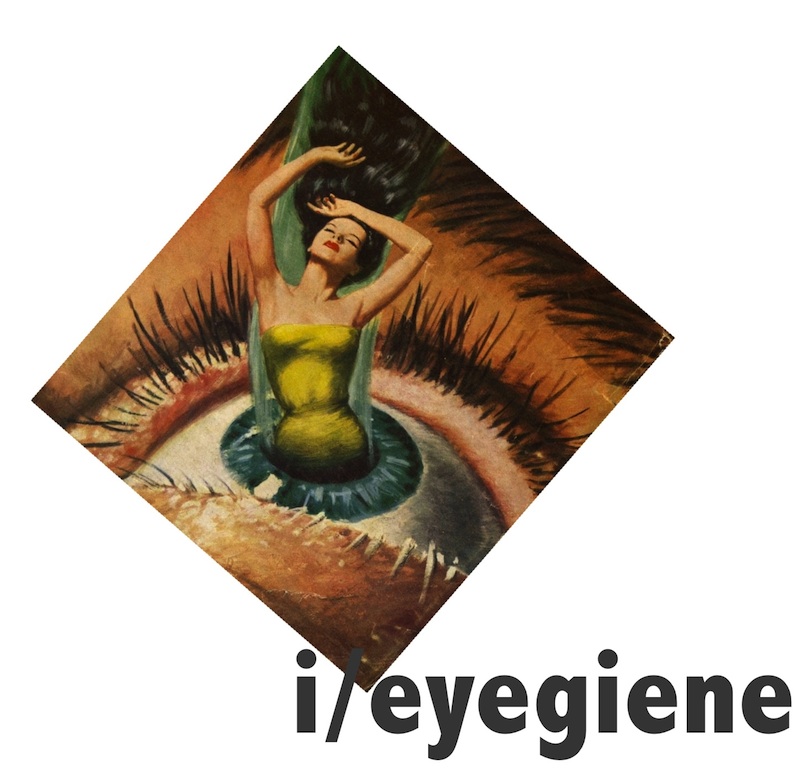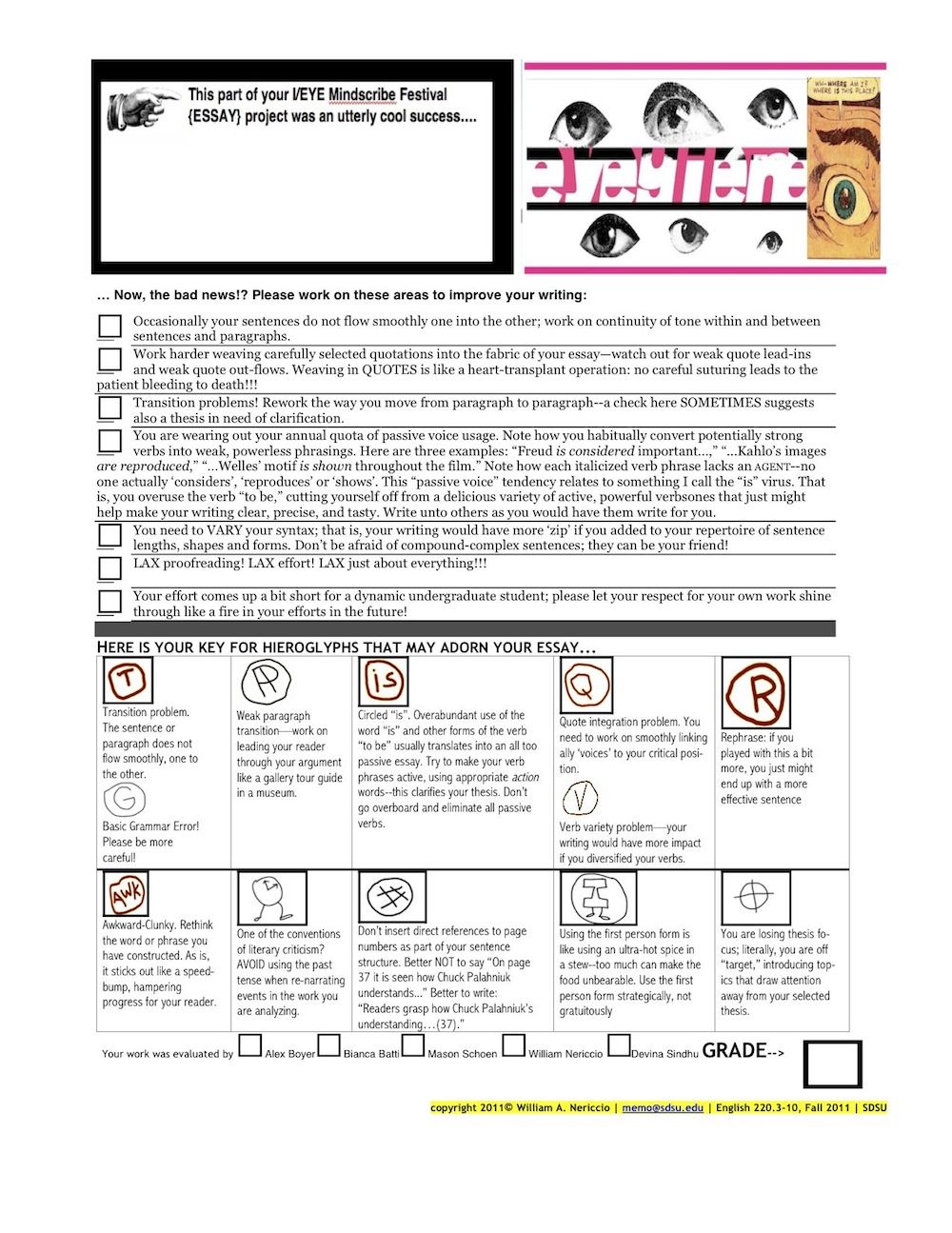 |
| Engl 220.3-220.10 | Fall 2011 |
| I/EYE Mindscribe Festival Challenge Numero DOS® urgent issues? email: memo@sdsu.edu | phone: 619.594.1524 Your essays will run anywhere from 4 to 7 pages (tops). At the top of the first page, above your title, you will write out the prompt to which you are responding. Your essay will be cleverly titled, double-spaced, have 1-inch margins top and sides and be carefully proofread; additionally, it will be chock-full of active verbs and, in general, have syntactic variety so as to avoid the dangers of the IS VIRUS; use MLA or University of Chicago-style works cited pages. Your works of genius are due: WEDNESDAY, NOVEMBER 16, 2011 @ 11am in CLASS, Peterson Gym 153 All A-level critical speculations will integrate carefully selected direct quotations from the primary texts and will avoid ALL of the quicksand-like bad habits noted here on the gradesheet to your left--click it to make it readable. ADDITIONALLY! All A-level work will make use of two pieces of outside criticism; this "criticism" must come from published, scholarly books located in LOVE LIBRARY--online resources are to be AVOIDED. That's right! I expect you to walk/stalk/prowl the "stacks" (aka, shelves of books) in Love Library. One last bit of advice, do NOT plagiarize ANY material from the Internet; non-CITED material = PLAGIARISM; also, if you are going to "quote" a passage from an illustrated text, go to the bother of xeroxing the image and incorporating it INTO your essay. Last hint? Have a blast with this paper! Try things you have NEVER tried before! Test the limits of your imagination! Especially for graduating seniors: put everything you know on and between the lines of your big scary imagination blow-out! Good luck: with your talents, you may not need it! ALSO!!! Do NOT write about any of the works you focused on in I/EYE Mindscribe Festival Challenge Numero UNO® Choose ONE of the following prompts... 1. As Touched by the Naked Eye Department Redefine the concept of the Naked Eye (only if you did not touch on this in your first paper for this class) using the work of OLIVER MAYER, HARUKI MURAKAMI, and/or ART SPIEGELMAN.2. Just What Are You Doing with That Camera Department Contrast the role of cameras in Michael Powell's PEEPING TOM and Penelope Lively's THE PHOTOGRAPH. 3. Metamorphosis/Transmogrification The theme of metamorphosis/transformation/change is present in many of our texts from this semester. Compare and contrast the use of this theme in BLADE TO THE HEAT, THE PHOTOGRAPH, and/or PEEPING TOM. 4. Grotesque Department Our readings from this semester are full of ugly, disfigured, repellent, creepy, and disturbing people and creatures. Discuss the significance of “the grotesque” in two or more texts we’ve studied. Some works to consider (you must use at least two in your essay) that deal with this theme are PEEPING TOM, NIGHT OF THE LIVING DEAD, BEYOND THE PLEASURE PRINCIPLE, and the ACME NOVELTY WAREHOUSE 5. Televisual Toolkit Time Department The Televisual Toolkit terms introduced this semester offer a treasure trove of analytical possibilities through which to explore our texts from this semester. Apply one or more of these terms to two or more of our readings in a well thought out analytical essay. As always, you should have a clear, arguable thesis that guides your exploration. Possible texts: PEEPING TOM, BLADE TO THE HEAT, BEYOND THE PLEASURE PRINCIPLE, AFTER DARK, and the ACME NOVELTY WAREHOUSE. 6. All Freud, All the Time Department In BEYOND THE PLEASURE PRINCIPLE, Sigmund Freud introduces the concept of the death drive, or the instinct that drives us toward death and self-destruction. This idea has, of course been extremely prevalent in many of the texts that we’ve discussed in this class. As such, analyze the manner in which the death instinct is represented in the films PEEPING TOM and NIGHT OF THE LIVING DEAD (you may also substitute/add BLADE TO THE HEAT or Spiegelman's BREAKDOWNS as well). Consider both similarities and differences in the ways that both films deal with the death drive, and also make sure to think about the overall significance of these films’ discussions of Freud’s themes. (Using direct quotations and references to BEYOND THE PLEASURE PRINCIPLE is a must!) 7. More Grotesque Department Consider the representation of the grotesque (remember: the grotesque is the fantastic, the strange, the disturbing, the unpleasant) in BREAKDOWNS by Art Spiegelman and THE WALKING DEAD (issue #1) by Robert Kirkman and Tony Moore, and ACME NOVELTY WAREHOUSE by Chris Ware; further, analyze the manner in which the manifestation of the grotesque (in the comic medium of these two texts) represents and reveals the notion of the fractured self. 8. The Medium is the Message Department Professor Nericcio quoted Marshall McLuhan, the Canadian communication theorist and his famous adage: “the medium is the message.” McLuhan maintains that the medium itself, as opposed to the content it carries, should be the first priority of study. Our recent explorations in ENGL 220 include the media of film, graphic novel, print fiction and non-fiction, and drama (if you read ahead to BLADE TO THE HEAT). Using one or more of these works, describe how the medium enhances, conveys, or contradicts the “message” of the content. 9. POV Department The POINT OF VIEW in a literary work impacts the reader/viewer by placing them in a particular role with respect to the spectacle presented. This POV encompasses the narrator’s perspective in print media, or the camera/artist’s position in graphic media or film. For example, in the title graphic for Art Spiegelman’s “Maus,” we view the incarcerated Jews from the outside, as if we are the Nazi Katzen; and in Penelope Lively’s THE PHOTOGRAPH, each chapter is narrated according to a particular character’s POV. Using examples from the works we have explored since the last essay, describe how the POV (or perhaps the absence of a particular POV) contributes to the reader/viewer’s experience of the work. 10. Sigmund! Sigmund! Redux Department Psychoanalysis, in part, was developed to explore our unconscious drives as a form of therapy. Use a psychoanalytic lens (in a way that would make Freud proud) to discover the complexities within the functioning of the psyche of the main character, author, director, or subjects in TWO of the works we have explored in this class (for example, you can choose Kettenmann’s portrayal of Frida Kahlo, Nericcio’s depiction of Rita Hayworth, Art Spiegelman from BREAKDOWNS, Mark Lewis from PEEPING TOM, Palahniuk’s Narrator, etc.). Use this method of interpretation in your essay, using evidence from Zarate and Appignanesi and Freud, in a way that will allow your reader to come to a deeper and perhaps more sympathetic understanding of the complexities of the characters/subjects you choose to analyze. This might serve as a therapeutic pursuit for YOU (the writer) in exploring the grotesque. DO NOT work on an author/work you touched in your first paper! 11. What is ART Department! In Art Spiegelman’s BREAKDOWNS, specifically in Portraits, the author/illustrator quotes the Russian formalist Victor Shlovsky, who states, “[t]he technique of art is to make things "unfamiliar," to make forms obscure, so as to increase the difficulty and the duration of perception. The act of perception in art is an end in itself and must be prolonged. In art, it is our experience of the process of construction that counts, not the finished product.” Art Spiegelman, the author, cuts into the panel and tells himself to “Shut up, and divert” the reader instead of pedantically discussing what the role of art should be. In an articulate and well-reasoned essay, discuss what you think the role of art should be, and use two works (pick from works that appeared after FIGHT CLUB, in class that help to elucidate how your vision of art is exemplified or contradicted by that artist’s particular vision. 12. Zombies as Audience Department As your GTA Bianca Batti pointed out during her Halloween lecture, the cover of THE WALKING DEAD, Issue 1 displays Rick Grimes standing before a clothing shop filled with torn-apart mannequins, representative of the destruction of society, its thoughts of perfection and even the superego. The zombies portrayed both in Robert Kirkman’s comic and George Romero’s film Night of the Living Dead act as spectators: hungry, constant voyeurs. Use Oliver Mayer’s BLADE TO THE HEAT and Michael Powell’s PEEPING TOM (in conjunction with the aforementioned zombie works) to explore the ways in which an audience’s expectations of a subject’s behavior and identity alter the way that subject acts and defines him or herself. Include expectations of gender and sexuality. Also consider the symbolic meaning of mirrors and reflections in these works. 13. Visual Arts as Suture or Scalpel Department Use Penelope Lively’s THE PHOTOGRAPH and Spiegelman’s comics, especially “Maus” and “Prisoner on the Hell Planet,” to investigate closure, and how mediums of art either reinforce notions of accepting a person’s death or reintroduce the trauma already lived through. Include Freudian theories discussed in his book BEYOND THE PLEASURE PRINCIPLE to bolster your interpretations and argument. 14. Deus ex YOU... Develop and refine your OWN independent thesis; you MUST bring your proposal to me by Wednesday, November 9th (typed, please). You are also welcome to run it by me in person during office hours or via email; if you email me a proposal, be sure to CC (include!) your GTA in the message... Good luck; do yourself a favor and pick a topic that really drives your crazy with curiosity; given that prompt 14 is an option, you are the only one to blame if you pick a subject/work/artist that does nothing for your imagination! |
